Selective Separation of 1-Butanol from Aqueous Solution through Pervaporation Using PTSMP-Silica Nano Hybrid Membrane
Abstract
:1. Introduction
2. Materials and Methodology
2.1. SNPs Surface Modification
2.2. Preparation of Membrane
2.3. Characterization of Membrane
2.3.1. Morphology Characterization
2.3.2. Contact angle Measurement
2.3.3. Thermogravimetric Analysis
2.4. Pervaporation System:
2.5. Gas Chromatography Analysis
2.6. Measurement of Transient Pervaporation for Butanol Diffusivity
2.7. Measurement of Steady Pervaporation
3. Results
4. Conclusions
Supplementary Materials
Author Contributions
Funding
Acknowledgments
Conflicts of Interest
Nomenclature
| A (m2) | Membrane area;. |
| D (m2/min) | Diffusivity |
| J (mg·cm−2·min−1) | Flux |
| l (µm) | Thickness |
| p (Pa) | Pressure |
| P (mg·cm·cm−2·min−1·kPa−1) | Permeability |
| R (J mol−1 K−1) | Universal gas constant |
| T (K or °C) | Temperature |
| x | Molar fraction |
Abbreviation
| ABE | Acetone butanol ethanol |
| FTIR | Fourier transform infrared spectroscopy |
| GC-MS | Gas chromatography mass spectrometry |
| HPLC | High Performance Liquid Chromatography |
| MFC | Mass flow controller |
| NRTL | Non-random two-liquid model |
| SNPs | Silica nano particles (Surface modified with CTAB) |
| STP | Standard temperature and pressure (273.15 K, 101.325 kPa)Greek letters |
| γ | Activity coefficient |
| β | Separation factor |
| α | Selectivity |
References
- Dürre, P. Biobutanol: An attractive biofuel. Biotechnol. J. 2007, 2, 1525–1534. [Google Scholar] [CrossRef]
- Lee, S.Y.; Park, J.H.; Jang, S.H.; Nielsen, L.K.; Kim, J.; Jung, K.S. Fermentative butanol production by Clostridia. Biotechnol. Bioeng. 2008, 10, 209–228. [Google Scholar] [CrossRef] [PubMed]
- Green, M.E. Fermentative production of butanol—The industrial perspective. Curr. Opin. Biotech. 2011, 22, 337–343. [Google Scholar] [CrossRef] [PubMed]
- Jin, C.; Yao, C.; Liu, H.; Lee, C.F.; Ji, J. Progress in the production and application of n-butanol as a biofuel. Renew. Sustain. Energy Rev. 2011, 15, 4080–4106. [Google Scholar] [CrossRef]
- Ibrahim, M.F.; Ramli, N.; Bahrin, E.K.; Abd-Aziz, S. Cellulosic biobutanol by Clostridia: Challenges and improvements. Renew. Sustain. Energy Rev. 2017, 79, 1241–1254. [Google Scholar] [CrossRef]
- Pugazhendhi, A.; Mathimani, T.; Varjani, S.; Rene, R.E.; Kumar, G.; Kim, S.-H.; Ponnusamy, V.K.; Yoon, J.-J. Biobutanol as a promising liquid fuel for the future—Recent updates and perspectives. Fuel 2019, 253, 637–646. [Google Scholar] [CrossRef]
- Singh, S. Global N Butanol Market Analysis & Trends—Industry Forecast to 2027; Research and Markets; Accuray Research LLP: Dublin, Ireland, 2018. [Google Scholar]
- Shao, P.; Huang, R. Polymeric membrane pervaporation. J. Membr. Sci. 2007, 287, 162–179. [Google Scholar] [CrossRef]
- Volkov, A.V.; Volkov, V.V.; Khotimskii, V.S. Membranes based on poly[(1-trimethylsilyl)-1-propyne] for liquid-liquid separation. Polym. Sci. Ser. A 2009, 51, 2113–2128. [Google Scholar] [CrossRef]
- Nagai, K.; Masuda, T.; Nakagawa, T.; Freeman, B.D.; Pinnau, I. Poly[1-(trimethylsilyl)-1-propyne] and related polymers: Synthesis, properties and functions. Prog. Polym. Sci. 2001, 26, 721–798. [Google Scholar] [CrossRef]
- Khotimsky, V.S.; Tchirkova, M.V.; Litvinova, E.G.; Rebrov, A.I.; Bondarenko, G.N. Poly[1-(trimethylgermyl)-1-propyne] and poly[1-(trimethylsilyl)-1-propyne] with various geometries: Their synthesis and properties. J. Polym. Sci. Part A Polym. Chem. 2003, 41, 2133–2155. [Google Scholar] [CrossRef]
- Volkov, V.V.; Fadeev, A.G.; Khotimsky, V.S.; Litvinova, E.G.; Selinskaya, Y.A.; McMillan, J.D.; Kelley, S.S. Effects of synthesis conditions on the pervaporation properties of Poly[1-(Trimethylsilyl)-1-Propyne] useful for membrane bioreactors. J. Appl. Polym. Sci. 2004, 91, 2271–2277. [Google Scholar] [CrossRef]
- Cheng, X.; Pan, F.; Wang, M.; Li, W.; Song, Y.; Liu, G.; Yang, H.; Gao, B.; Wu, H.; Jiang, Z. Hybrid membranes for pervaporation separations. J. Membr. Sci. 2017, 541, 329–346. [Google Scholar] [CrossRef]
- Zhang, H.; Li, B.; Sun, D.; Miao, X.; Gu, Y. SiO2-PDMS-PVDF hollow fiber membrane with high flux for vacuum membrane distillation. Desalination 2018, 429, 33–43. [Google Scholar] [CrossRef]
- Heidari, M.; Hosseini, S.S.; Narsin, M.O.; Ghadimi, A. Synthesis and fabrication of adsorptive carbon nanoparticles (ACNs)/PDMS mixed matrix membranes for efficient CO2/CH4 and C3H8/CH4 separation. Sep. Purif. Technol. 2019, 209, 503–515. [Google Scholar] [CrossRef]
- Suhas, D.P.; Aminabhavi, T.M.; Raghu, A.V. Para-toluene sulfonic acid treated clay loaded sodium alginate membranes for enhanced pervaporative dehydration of IPA. Appl. Clay Sci. 2014, 101, 419–429. [Google Scholar] [CrossRef]
- Sudhakar, H.V.; Prasad, C.; Sunitha, K.C.; Rao, K.; Subha, M.; Sridhar, S. Pervaporation separation of IPA-water mixtures through 4A zeolite-filled sodium alginate membranes. J. Appl. Polym. Sci. 2011, 121, 2717–2725. [Google Scholar] [CrossRef]
- Shirazi, Y.; Tofighy, A.M.; Mohammadi, T. Synthesis and characterization of carbon nanotubes/poly vinyl alcohol nanocomposite membranes for dehydration of isopropanol. J. Membr. Sci. 2011, 378, 551–561. [Google Scholar] [CrossRef]
- Bouša, D.; Friess, K.; Pilnáček, K.; Vopička, O.; Lanč, M.; Fónod, K.; Pumera, M.; Sedmidubský, D.; Luxa, J.; Sofer, Z. Thin high flux self-standing graphene oxide membranes for efficient hydrogen separation from gas mixtures. Chem. Eur. J. 2017, 23, 11416–11422. [Google Scholar] [CrossRef]
- Xu, Y.M.; Japip, S.; Chung, T.S. Mixed matrix membranes with nano-sized functional UiO-66-type MOFs embedded in 6FDA-HAB/DABA polyimide for dehydration of C1-C3 alcohols via pervaporation. J. Membr. Sci. 2018, 549, 217–226. [Google Scholar] [CrossRef]
- Cheng, Y.; Ying, Y.; Zhai, L.; Liu, G.; Dong, J.; Wang, Y.; Christopher, M.P.; Long, S.; Wang, Y.; Zhao, D. Mixed matrix membranes containing MOF@COF hybrid fillers for efficient CO2/CH4 separation. J. Membr. Sci. 2019, 573, 97–106. [Google Scholar] [CrossRef]
- Casado-Coterillo, C.; Fernández-Barquín, A.; Irabien, A. Effect of humidity on CO2/N2 and CO2/CH4 separation using novel robust mixed matrix composite hollow fiber membranes: Experimental and model evaluation. Membranes 2020, 10, 6. [Google Scholar] [CrossRef] [PubMed] [Green Version]
- Claes, R.; Vandezande, P.; Mullens, S.; Sitter, K.D.; Peeters, R.; Van Bael, M.K. Preparation and benchmarking of thin film supported PTMSP-silica pervaporation membranes. J. Membr. Sci. 2012, 389, 265–271. [Google Scholar] [CrossRef]
- Jyothi, M.S.; Reddy, K.R.; Soontarapa, K.; Naveen, S.; Raghu, A.V.; Kulkarni, R.V.; Suhas, D.P.; Shetti, N.P.; Nadagouda, M.N.; Aminabhavi, T.M. Membranes for dehydration of alcohols via pervaporation. J. Environ. Manag. 2019, 242, 415–429. [Google Scholar] [CrossRef] [PubMed]
- Torabi, B.; Ameri, E. Methyl acetate production by coupled esterification-reaction process using synthesized cross-linked PVA/silica nanocomposite membranes. Chem. Eng. J. 2016, 288, 461–472. [Google Scholar] [CrossRef]
- Talluri, V.P.; Patakova, P.; Moucha, T.; Vopicka, O. Transient and steady pervaporation of 1-butanol–water mixtures through a poly[1 -(trimethylsilyl)-1-propyne] (ptmsp) membrane. Polymers 2019, 11, 1943. [Google Scholar] [CrossRef] [Green Version]
- Design Institute for Physical Properties, Sponsored by AICHE (2005; 2008; 2009; 2010). Dippr Project 801—Full Version. Design Institute for Physical Property Research/AICHE. Available online: http://knovel.com/web/toc.v/cid:kpDIPPRPF7/viewerType:toc/root_slug:dippr-project-801-full/url_slug:dippr-project-801-full/? (accessed on 11 November 2019).
- Nagai, K.; Higuchi, A.; Nakagawa, T. Gas permeability and stability of poly(1-trimethylsilyl-1-propyne-co-1- phenyl-1-propyne) membranes. J. Polym. Sci. Part B Polym. Phys. 1995, 33, 289–298. [Google Scholar] [CrossRef]
- Vopicka, O.; Radotínský, D.; Friess, K. Sorption of vapor mixtures of methanol and dimethyl carbonate in PDMS: Experimental study. Eur. Polym. J. 2015, 73, 480–486. [Google Scholar] [CrossRef]
- Radotínský, D.; Vopicka, O.; Hynek, V.; Izák, P.; Friess, K. Aparatura pro stanovení sorpce a permeace organických par v polymerech pomocí infranoervené spektroskopie. Chem. Listy 2015, 109, 619–624. (In Czech) [Google Scholar]
- Baker, R.; Wijmans, J.; Huang, Y. Permeability, permeance and selectivity: A preferred way of reporting pervaporation performance data. J. Membr. Sci. 2010, 348, 346–352. [Google Scholar] [CrossRef]
- Renon, H.; Prausnitz, J. Local compositions in thermodynamic excess functions for liquid mixtures. AIChE J. 1968, 14, 135–144. [Google Scholar] [CrossRef]
- KoichiI, W.; Hitoshi, K. A correlation method for isobaric vapor–liquid and vapor–liquid–liquid equilibria data of binary systems. Fluid Phase Equilibria 2008, 266, 202–210. [Google Scholar]
- Sitter, K.D.; Leysen, R.; Mullens, S.; Vankelecom, I.; Maurer, F. Silica filled poly(1-trimethylsilyl-1-propyne) and poly(4-methyl-2-pentyne) membranes: Similarities and differences in structural characteristics and membrane performances. Desalination 2006, 199, 293–295. [Google Scholar] [CrossRef]
- Feng, X.; Huang, Y.M. Estimation of activation energy for permeation in pervaporation processes. J. Membr. Sci. 1996, 118, 127–131. [Google Scholar] [CrossRef]
- Yakovlev, A.V.; Shalygin, M.G.; Matson, S.M.; Khotimskiy, V.S.; Teplyakov, V.V. Separation of diluted butanol–water solutions via vapor phase by organophilic membranes based on high permeable polyacetylenes. J. Membr. Sci. 2013, 434, 99–105. [Google Scholar] [CrossRef]
- Borisov, I.L.; Malakhov, A.O.; Khotimsky, V.S.; Litvinova, E.G.; Finkelshtein, E.S.; Ushakov, N.V.; Volkov, V.V. Novel PTMSP-based membranes containing elastomeric fillers: Enhanced 1-butanol/water pervaporation selectivity and permeability. J. Membr. Sci. 2014, 466, 322–330. [Google Scholar] [CrossRef]
- Fadeev, A.G.; Selinskaya, Y.A.; Kelley, S.S.; Meagher, M.M.; Litvinova, E.G.; Khotimsky, V.S.; Volkov, V.V. Extraction of butanol from aqueous solutions by pervaporation through poly(1-trimethylsilyl-1-propyne). J. Membr. Sci. 2001, 186, 205–217. [Google Scholar] [CrossRef]
- Li, S.; Qin, F.; Qin, P.; Karim, M.N.; Tan, T. Preparation of PDMS membrane using water as solvent for pervaporation separation of butanol-water mixture. Green Chem. 2013, 15, 2180–2190. [Google Scholar] [CrossRef]
- Liu, F.; Liu, L.; Feng, X. Separation of acetone–butanol–ethanol (ABE) from dilute aqueous solutions by pervaporation. Sep. Purif. Technol. 2005, 42, 273–282. [Google Scholar] [CrossRef]
- Yen, H.-W.; Chen, Z.-H.; Yang, I.K. Use of the composite membrane of poly(ether-block-amide) and carbon nanotubes (CNTS) in a pervaporation system incorporated with fermentation for butanol production by clostridium acetobutylicum. Bioresour. Technol. 2012, 109, 105–109. [Google Scholar] [CrossRef]
- Huang, J.; Meagher, M.M. Pervaporative recovery of n-butanol from aqueous solutions and abe fermentation broth using thin-film silicalite-filled silicone composite membranes. J. Membr. Sci. 2001, 192, 231–242. [Google Scholar] [CrossRef]
- Liu, G.; Hou, D.; Wei, W.; Xiangli, F.; Jin, W. Pervaporation Separation of Butanol-Water Mixtures Using Polydimethylsiloxane/Ceramic Composite Membrane. Chin. J. Chem. Eng. 2011, 19, 40–44. [Google Scholar] [CrossRef]
- Golubev, G.S.; Borisov, I.L.; Volkov, V.V.; Volkov, A.V. High-Performance Reinforced PTMSP Membranes for Thermopervaporation Removal of Alcohols from Aqueous Media. Membr. Membr. Technol. 2020, 2, 45–53. [Google Scholar] [CrossRef] [Green Version]
- Ueno, K.; Yamada, S.; Watanabe, T.; Negishi, H.; Okuno, T.; Tawarayama, H.; Ishikawa, S.; Miyamoto, M.; Uemiya, S.; Oumi, Y. Hydrophobic *BEA-Type Zeolite Membranes on Tubular Silica Supports for Alcohol/Water Separation by Pervaporation. Membranes. 2019, 9, 86. [Google Scholar] [CrossRef] [PubMed] [Green Version]

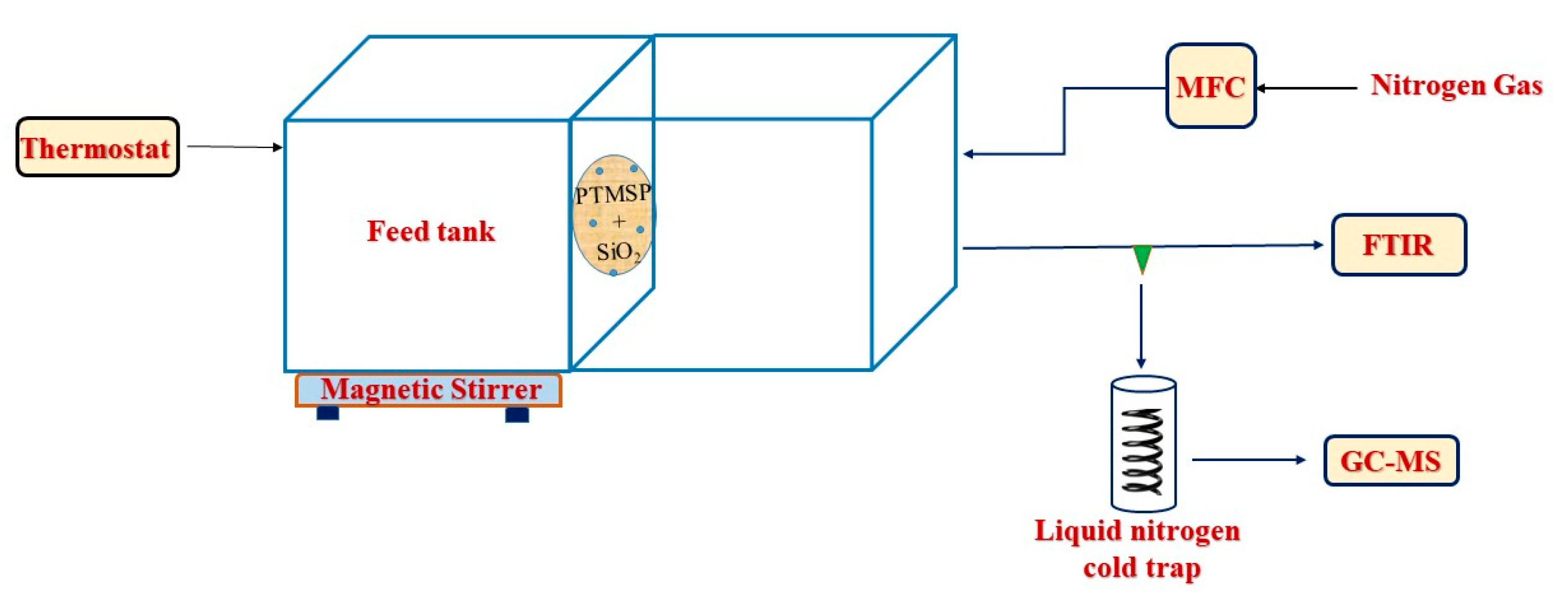
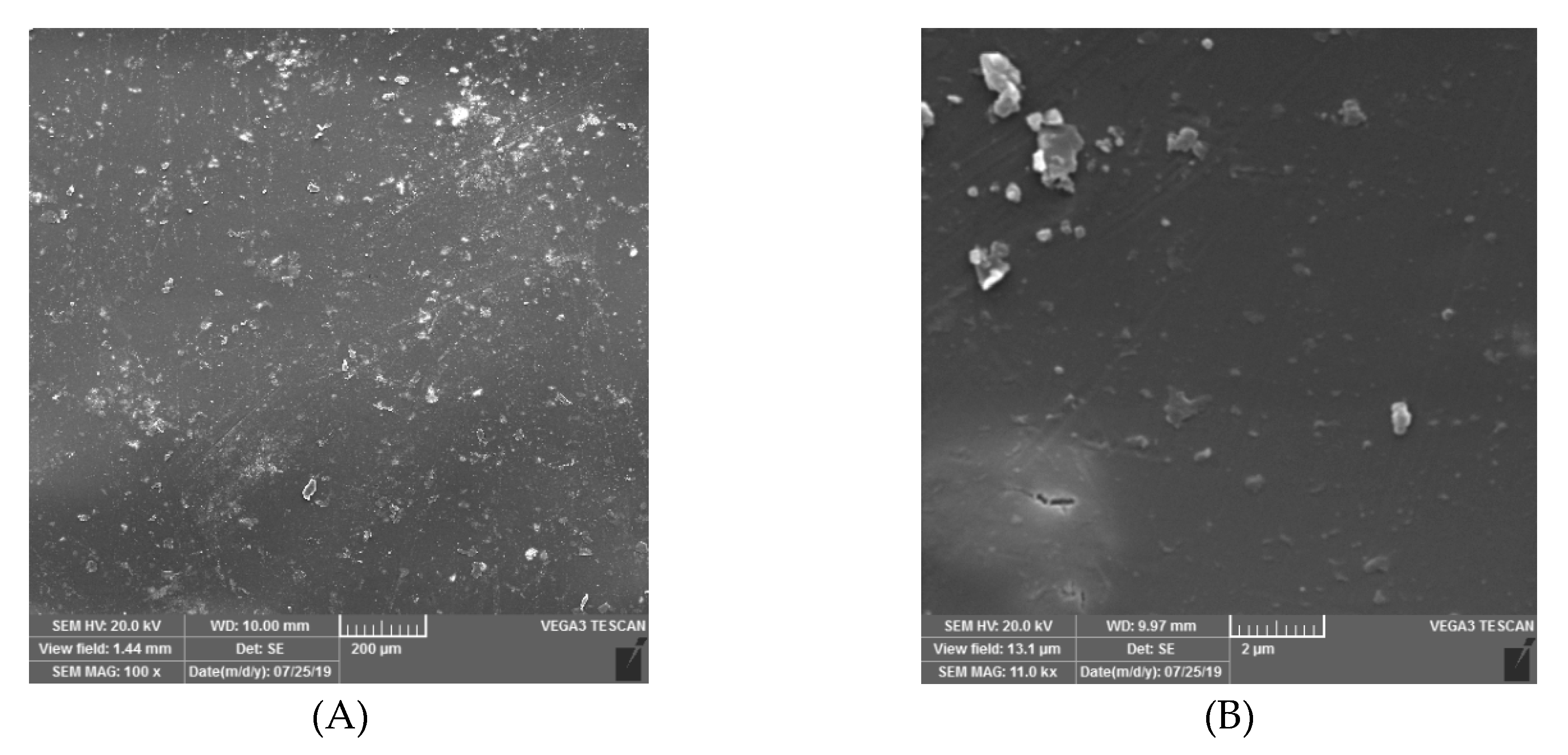
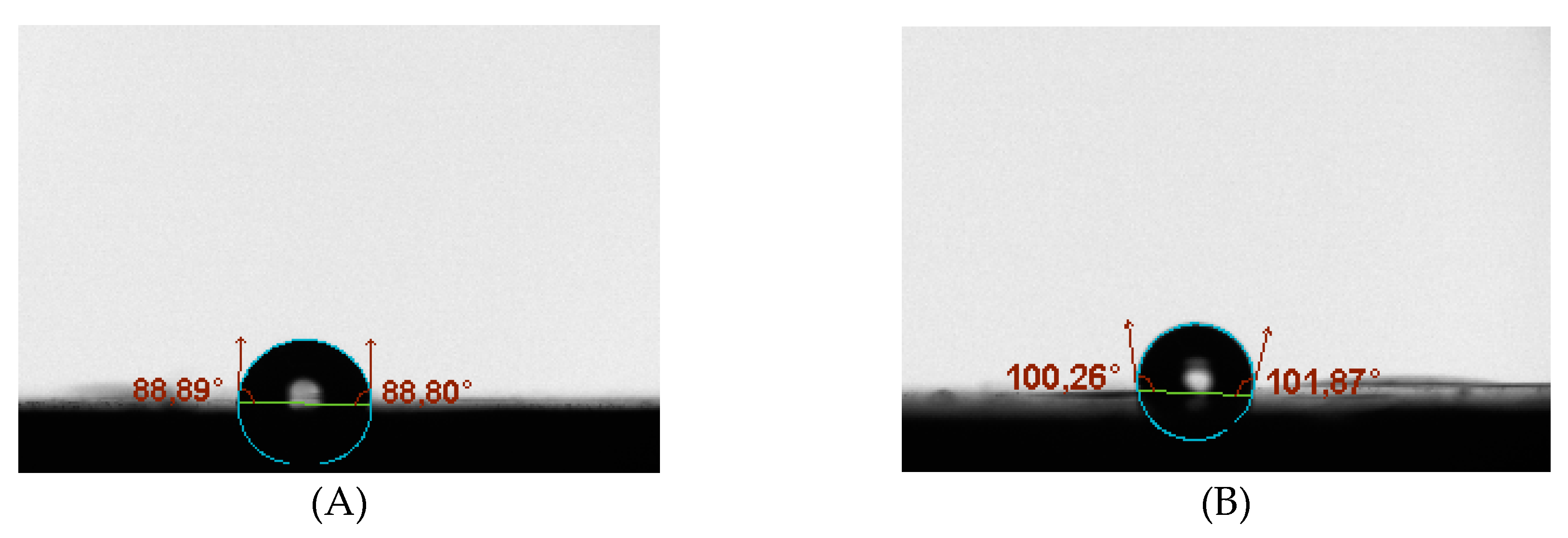


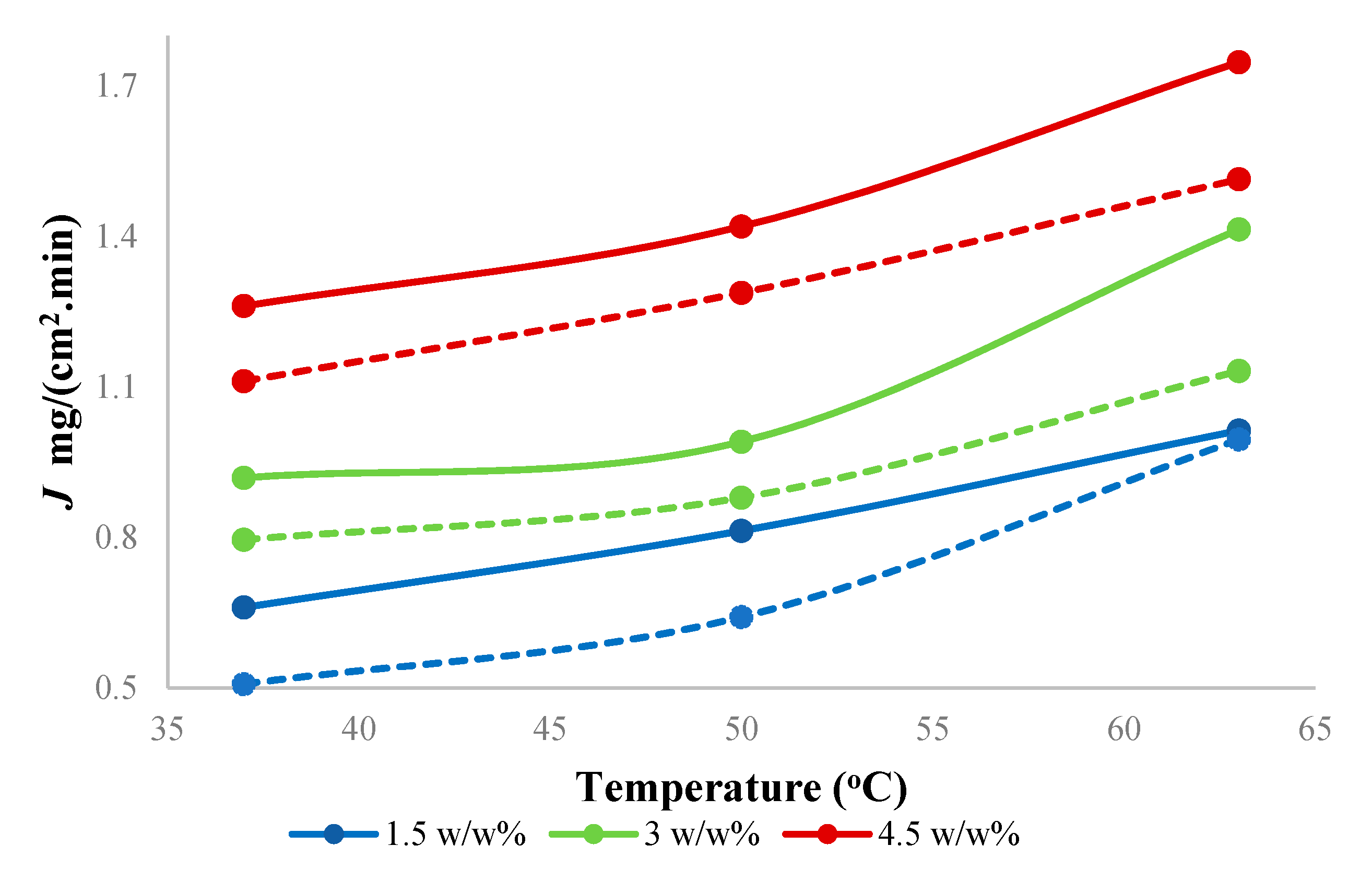
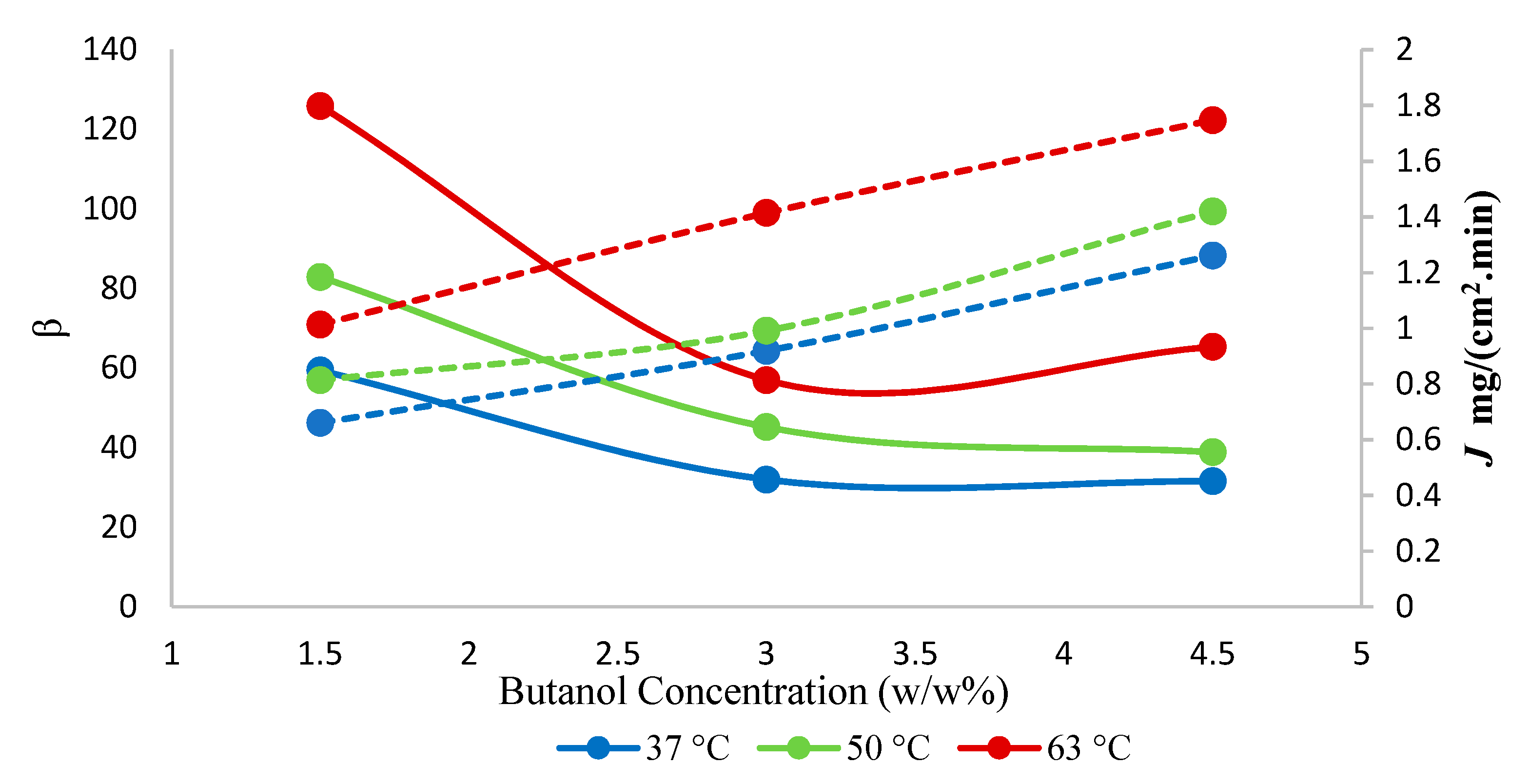


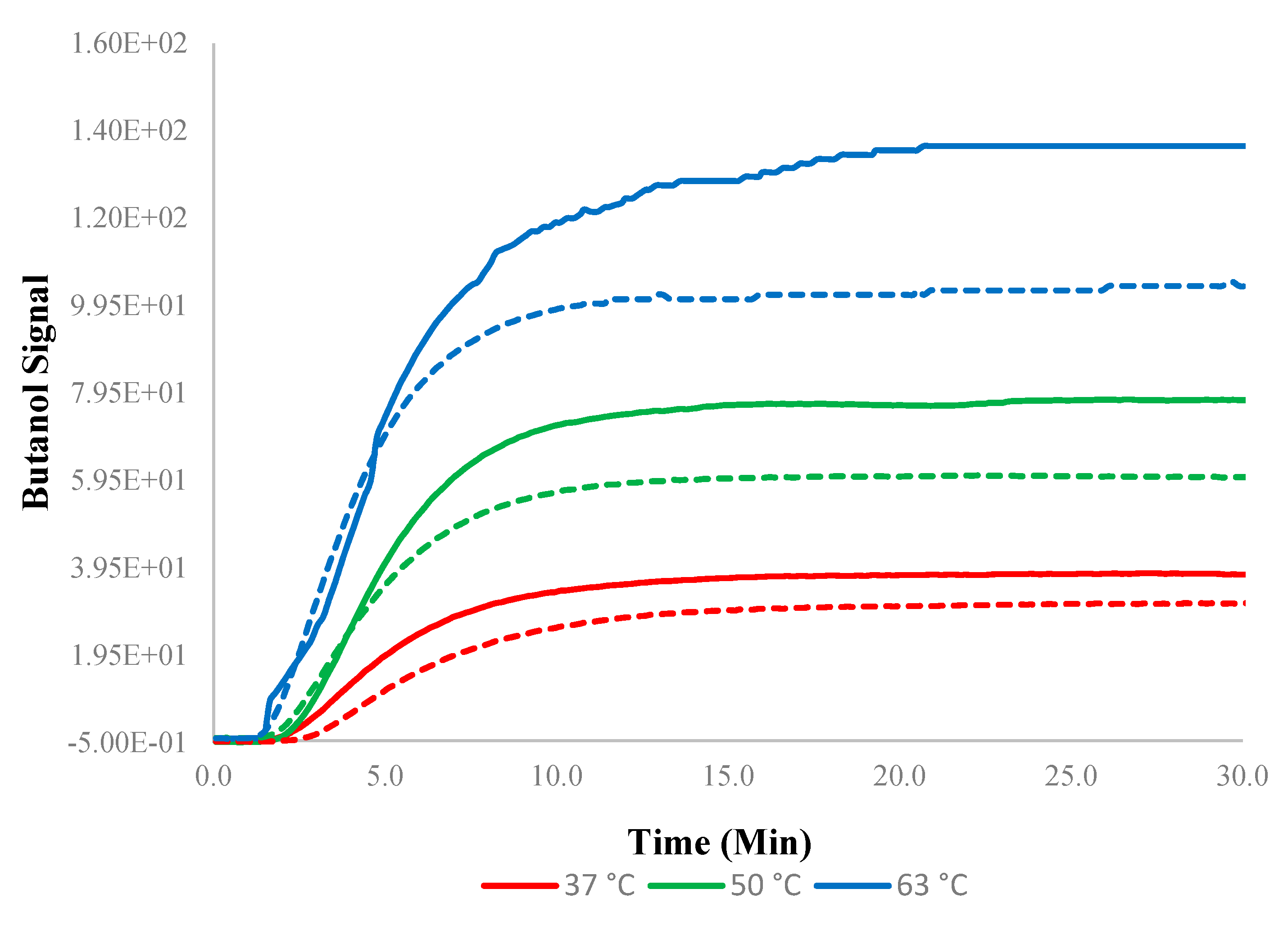
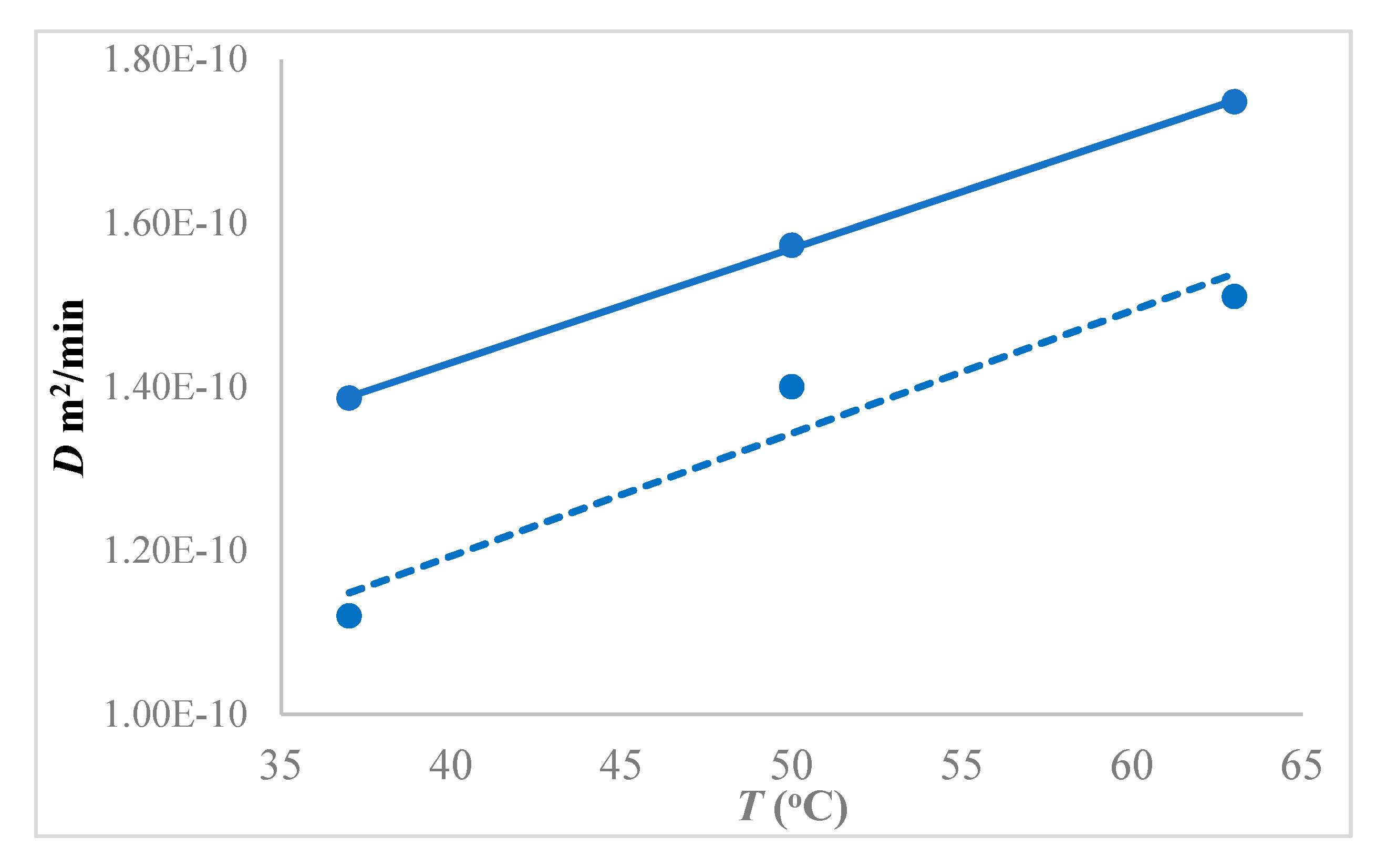
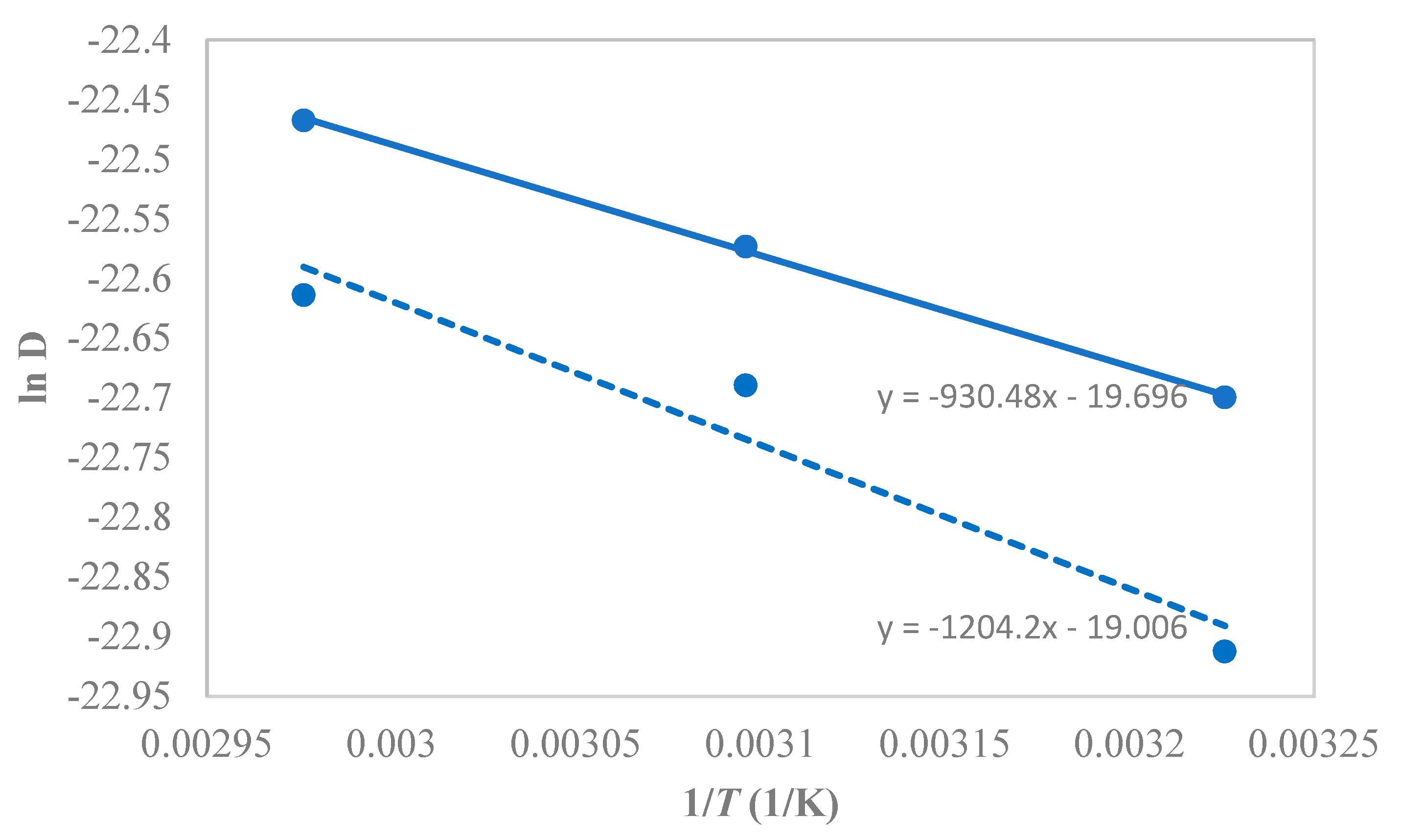
| Membrane Type | Thickness (µm) | Temperature (°C) | Feed Concentration (Butanol) | Total Flux (g·m−2·h−1) | Separation Factor | Reference |
|---|---|---|---|---|---|---|
| PTMSP-silica | 2.4 | 50 | 5 wt% | 950 | 104 | [23] |
| PTMSP/PDMSM | 30 | 25 | 2 wt% | 120 | 128 | [37] |
| Pure PTMSP | 22 | 25 | 1.5 wt% | 60 | 55 | [38] |
| Pure PDMS | 30 | 55 | 1.5 wt% | 720 | 34 | [39] |
| PEBA 2533 | 100 | 23 | 5 wt% | 32 | 12 | [40] |
| PEBA with CNT (10%) | 50 | 37 | 1 wt% | 139 | 18 | [41] |
| PDMS filled silicalite-1 | 19 | 50 | 1 wt% | 191 | 111 | [42] |
| PDMS/ceramic composite membrane | 10 | 40 | 1 wt% | 457 | 26 | [43] |
| Reinforced PTMSP/stainless steel | 40 | 60 | 1.0 wt% | 560 | 83 | [44] |
| BEA-type zeolite membranes | - | 45 | 1 wt% | 620 | 229 | [45] |
| Our work with pure PTMSP | 46 | 37 | 1.5 wt% | 85 | 67 | [26] |
| PTMSP-SNPs (modified silica nanoparticles) | 48 | 37 | 1.5 wt% | 110 | 59 | Present work |
| 48 | 50 | 1.5 wt% | 135 | 83 | ||
| 48 | 63 | 1.5 wt% | 165 | 126 |
© 2020 by the authors. Licensee MDPI, Basel, Switzerland. This article is an open access article distributed under the terms and conditions of the Creative Commons Attribution (CC BY) license (http://creativecommons.org/licenses/by/4.0/).
Share and Cite
Talluri, V.P.; Tleuova, A.; Hosseini, S.; Vopicka, O. Selective Separation of 1-Butanol from Aqueous Solution through Pervaporation Using PTSMP-Silica Nano Hybrid Membrane. Membranes 2020, 10, 55. https://doi.org/10.3390/membranes10040055
Talluri VP, Tleuova A, Hosseini S, Vopicka O. Selective Separation of 1-Butanol from Aqueous Solution through Pervaporation Using PTSMP-Silica Nano Hybrid Membrane. Membranes. 2020; 10(4):55. https://doi.org/10.3390/membranes10040055
Chicago/Turabian StyleTalluri, VSSL Prasad, Aiym Tleuova, Seyedmehdi Hosseini, and Ondrej Vopicka. 2020. "Selective Separation of 1-Butanol from Aqueous Solution through Pervaporation Using PTSMP-Silica Nano Hybrid Membrane" Membranes 10, no. 4: 55. https://doi.org/10.3390/membranes10040055
APA StyleTalluri, V. P., Tleuova, A., Hosseini, S., & Vopicka, O. (2020). Selective Separation of 1-Butanol from Aqueous Solution through Pervaporation Using PTSMP-Silica Nano Hybrid Membrane. Membranes, 10(4), 55. https://doi.org/10.3390/membranes10040055





